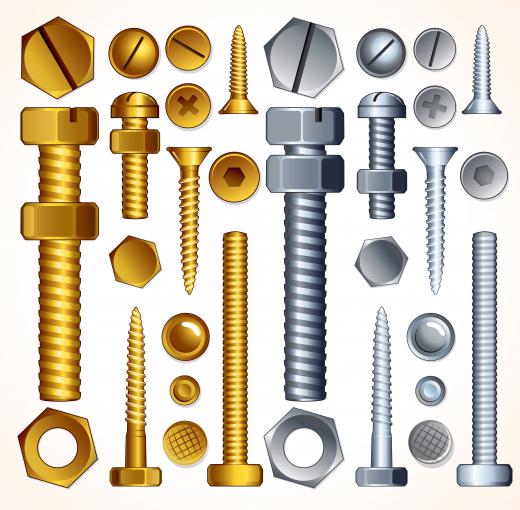When metal hardware is exposed to moisture, it can rust or corrode. To counteract this problem, manufacturers can anodize the metals, creating a protective layer that will prevent damage from rust and corrosion. Anodized bolts are any type of bolt that has been treated with the anodization process. Some manufacturers will even dye the metals when creating anodized bolts to make visible bolts more attractive. In other cases, it may not be evident that the bolt has been anodized simply by looking at it.
Ferrous metals, or metals that contain iron, are most likely to be anodized, though such metals are often galvanized instead. Galvanization is the process of applying a protective layer of zinc to the metal, which is advantageous for ferrous metals. Steel is a common material used for anodized bolts, though aluminum is a very common material as well. Steel bolts are perhaps the most commonly used because they are durable and strong, and the anodization process makes them resistant to water damage. Aluminum anodized bolts are generally used for lighter-duty applications, as aluminum is a lightweight metal that can be fairly brittle; this means the bolts may be susceptible to cracking or shearing more easily than steel bolts will be.

Aluminum bolts tend to be anodized more often than steel because the steel reacts better to galvanization than it does to anodization. Aluminum anodized bolts are also often dyed during the process, making them an attractive choice for automobiles, motorcycles, bicycles, and any other vehicle that relies on strength as well as aesthetic appeal. Once the aluminum has been anodized, the metal must be deionized to help seal the anodized surface, protecting it further from corrosion. This is usually done by submerging the anodized bolts in deionized water for an extended period of time.

When anodized bolts are made, the surface of the bolts are raised, thereby increasing the surface area of the bolt. This is usually not too problematic, though it can be an issue if the bolt must be threaded into a nut to a tight tolerance. The added surface area may cause the bolt to bind, thereby increasing the likelihood that the bolt can strip or the threads of the bolt may bind up during application. Aluminum does tend to be brittle, so when binding occurs, breakage is likely.
